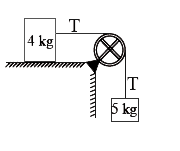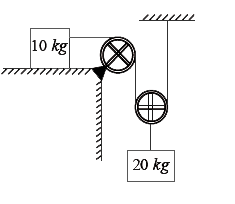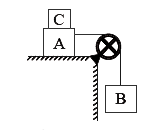Two bodies of masses 7 kg and 5 kg are connected by a light string passing over a smooth pulley at the edge of the table as shown in the figure. The coefficient of static friction between the surfaces (body and table) is 0.9. Will the mass m1 = 7 kg on the surface move? If not what value of m2 should be used so that mass 7 kg begins to slide on the table?Solution in Tamil
As shown in the figure, there are four forces acting on the mass m1

(a) Downward gravitational force along the negative y-axis (m1g)
(b) Upward normal force along the positive y-axis (N)
(c) Tension force due to mass m2 along the positive x axis
(d) Frictional force along the negative x-axis Since the mass m, has no vertical motion, m1g=N
Free body diagram for mass m1
To determine whether the mass m, moves on the surface, calculate the maximum static friction exerted by the table on the mass m. If the tension on the mass m, is equal to or greater than this maximum static friction, the object will move.
fmaxs=μsm1g
fmaxs=0.9×7×9.8=61.74N
The tension T =m2g=5×9.8×49N
T<fmaxs
The tension acting on the mass m1=T>fmaxs, when T=mg
m2=μsm1gg=μsm1
m2=0.9×7=6.3kg
If the mass m2 is greater than 6.3 kg then the mass m1 will begin to slide. Note that if there is no friction on the surface, the mass m1 will move for m2 even for just 1 kg. The values of coefficient of static friction for pairs of materials are given. Note that the ice and ice pair have very low coefficient of static friction. This means a block of ice can move easily over another block of ice.
Topper's Solved these Questions
- BOOK - FULL MARKSCHAPTER - LAW OF MOTION EXERCISE - TEXTUAL QUESTIONS SOLVED (MULTIPLE CHOICE QUESTIONS)15videos
LAW OF MOTION
- BOOK - FULL MARKSCHAPTER - LAW OF MOTION EXERCISE - TEXTUAL QUESTIONS SOLVED (SHORT ANSWER QUESTIONS)21videos
LAW OF MOTION
- BOOK - FULL MARKSCHAPTER - KINETIC THEORY OF GASESEXERCISE - Addtional Numerical Problems10videos
KINETIC THEORY OF GASES
- BOOK - FULL MARKSCHAPTER - MOTION OF SYSTEM OF PARTICLES AND RIGID BODIESEXERCISE - ADDITIONAL QUESTIONS SOLVED - III (LONG ANSWER QUESTIONS (5 MARKS))6videos
MOTION OF SYSTEM OF PARTICLES AND RIGID BODIES
Similar Questions
When a car takes a sudden left turn in the curved road passendgers are pushed towards the right due to
04:16View SolutionExplain the concept of inertia write two examples each inertia of motion inertia of rest and inertia of direction
03:53View SolutionIf the rms speed of hydrogen molecules at 300K is1930ms−1. Then what is the rms speed of oxygen molecules at 1200K.
04:00View SolutionDerive an expression for center of mass for distributed point masses.
02:51View SolutionTwo blocks A and B , each of mass 10 kg , are connected by a light string passing over a smooth pulley as shown in the figure. Block A will remain at rest if the friction on it is
04:49View SolutionTwo masses A and B of 10 kg and 5 kg , respectively , are connected with a string passing over a frictionless pulley fixed at the corner of a table as shown. The coefficient of static friction between A and the table is 0.2 . The minimum mass C that should be placed on A to prevent it from moving is equal to
03:18View SolutionA body of mass 20 kg is moving on a rough horizxontal plane. A block of mass 3 kg is connected to the 20 kg mass by a string of negligible mass through a smooth pulley as shown in the figure. The coefficient of kinetic friction between the heavier mass and teh surface is (g=10m//s^(2)).
05:27View SolutionTwo bodies of 5 kg and 4 kg are tied to a string as shown in the figure. If the surface and pulley both are smooth, acceleration of 5 kg body will be equal to :
 04:38View Solution
04:38View SolutionTwo masses of 10 kg and 20 kg are connected with an inextensible string passing over two smooth pulleys as shown in the figure. The acceleration of 20 kg mass will be :
 05:36View Solution
05:36View SolutionTwo blocks A and B of respective masses 6 kg and 4 kg are connected with a string passing over a light friction less pulley as shown in the figure . The coefficient of friction between the block A and horizontal surface is 0.4 . Then the minimum mass of block C which should be placed over A to prevent it from moving is :
 03:33View Solution
03:33View SolutionTwo bodies of masses 5 kg and 3 kg respectively are connected to two ends of a light string passing over horinzontal frictionless pulley. The tension in the string is
04:53View SolutionA book of mass 5 kg is kept on a horizontal table. It is connected to a weight of mass 2 kg by a weightless string passing over a smooth pulley . The part of the string on the table is horizontal, and the weight is hanging freely from the pulley. If the coefficient of kinetic friction between the table and the block is 0.2, find the acceleration of the block. What will be the tension in the string ?
02:26View SolutionA body of mass 20 kg is moving on a rough horizxontal plane. A block of mass 3 kg is connected to the 20 kg mass by a string of negligible mass through a smooth pulley as shown in the figure. The coefficient of kinetic friction between the heavier mass and teh surface is (g=10m//s^(2)).
04:05View SolutionA body of mass 20 kg is resting on a table. A light string is attached to it and passed over a smooth pulley at the edge of the table and a mass 3kg is attached at the free end. What is the acceleration of the system of the coefficient of kinetic friction between the mass and the table is 0.04 ? What is the tension in the string ?
02:43View SolutionTwo masses A and B of 10kg and 5kg, respectively , are connected with a string passing over a frictionless pulley fixed at the corner of a table as shown. The coefficient of static friction between A and the table is 0.2. The minimum mass C that should be placed on A to prevent it from moving is equal to
 04:58View Solution
04:58View Solution
